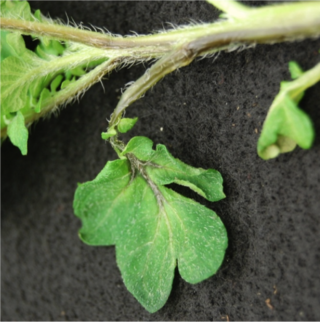
Dickeya dadantii is a gram-negative bacillus that belongs to the family Pectobacteriaceae. It was formerly known as Erwinia chrysanthemi but was reassigned as Dickeya dadantii in 2005. Members of this family are facultative anaerobes, able to ferment sugars to lactic acid, have nitrate reductase, but lack oxidases. Even though many clinical pathogens are part of the order Enterobacterales, most members of this family are plant pathogens. D. dadantii is a motile, nonsporing, straight rod-shaped cell with rounded ends, much like the other members of the genus, Dickeya. Cells range in size from 0.8 to 3.2 μm by 0.5 to 0.8 μm and are surrounded by numerous flagella (peritrichous).
Pseudomonas amygdali is a Gram-negative plant pathogenic bacterium. It is named after its ability to cause disease on almond trees. Different analyses, including 16S rRNA analysis, DNA-DNA hybridization, and MLST clearly placed P. amygdali in the P. syringae group together with the species Pseudomonas ficuserectae and Pseudomonas meliae, and 27 pathovars of Pseudomonas syringae/Pseudomonas savastanoi, constituting a single, well-defined phylogenetic group which should be considered as a single species. This phylogenetic group has not been formally named because of the lack of reliable means to differentiate it phenotypically from closely related species, and it is currently known as either genomospecies 2 or phylogroup 3. When it is formally named, the correct name for this new species should be Pseudomonas amygdali, which takes precedence over all the other names of taxa from this group, including Pseudomonas savastanoi, which is and inadequate and confusing name whose use is not recommended.

Dickeya solani is a bacterium that causes blackleg and soft rot in potato crops. Its symptoms are often indistinguishable from those caused by Pectobacterium but is more virulent, causing disease from lower levels of inoculum and spreading through the plant more effectively.
Dickeya is a genus of the family Pectobacteriaceae that consists mainly of pathogens from herbaceous plants. Dickeya is the result of the reclassification of 75 strains of Pectobacterium chrysanthemi, as well as Brenneria paradisiaca CFBP 4178, into a new genus. The genus is named for American phytopathologist Robert S. Dickey. Several species in this genus, such as Dickeya dadantii, are known phytopathogens.
Borrelia lusitaniae is a bacterium of the spirochete class of the genus Borrelia, which has a diderm (double-membrane) envelope. It is a part of the Borrelia burgdorferisensu lato genospecies and is a Gram-negative bacterium. B. lusitaniae is tick-borne; he type strain is PotiB2. It can be pathogenic, being involved in cases of Lyme borreliosis. A species of tick, Ixodes ricinus, is the host of B. lusitaniae. It is thought to have originated from Portugal and has since spread to parts of Europe and North Africa. Lizards of the family Lacertidae are now believed to be important reservoir hosts of this bacterium.
Vibrio coralliilyticus is a Gram-negative, rod-shaped bacterium. It has a polar flagellum that is used for motility and has been shown to be critical for its virulence to corals. It is a versatile pathogen, impacting several marine invertebrates including Pocillopora damicornis corals, both the Pacific and Eastern Oyster's larvae and some vertebrates such as the rainbow trout. It is a bacterium of considerable interest given its direct contribution to temperature dependent coral bleaching as well as its impacts on aquaculture where it can contribute to significant mortalities in larval oyster hatcheries. There are several known virulent strains, which appear on both the Pacific and Atlantic Coasts of the United States. After its initial discovery some strains were incorrectly classified as Vibrio tubiashii including the RE22 and RE98 strains but were later reclassified as Vibrio coralliilyticus.
Bradyrhizobium canariense is a species of legume-root nodulating, endosymbiont nitrogen-fixing bacterium. It is acid-tolerant and nodulates endemic genistoid legumes from the Canary Islands. The type strain is BTA-1T.
Methanolobus profundi is a mesophilic, methylotrophic methanogen archaeon. The type strain is MobMT. It was isolated from a deep subsurface gas field.

Pectobacterium atrosepticum is a species of bacterium. It is a plant pathogen causing blackleg of potato. Its type strain is CFBP 1526T. Its genome has been sequenced.
Pectobacterium betavasculorum is a plant pathogenic bacterium that infects beets. It can cause significant losses during sugar beet production and storage. Little is known about the epidemiology of this disease. Its type strain is CFBP 2122T.
Bradyrhizobium yuanmingense is a species of legume-root nodulating, endosymbiont nitrogen-fixing bacterium, associated with Lespedeza and Vigna species. Its type strain is CCBAU 10071(T).
Bradyrhizobium iriomotense is a species of legume-root nodulating, endosymbiont nitrogen-fixing bacterium, first isolated from Entada koshunensis. The type strain is EK05T.
Pelobacter carbinolicus is a species of bacteria that ferments 2,3-butanediol and acetoin. It is Gram-negative, strictly anaerobic and non-spore-forming. Gra Bd 1 is the type strain. Its genome has been sequenced.
Erwinia pyrifoliae is a Gram-negative bacterium and a phytopathogen of Asian pear trees, causing necrotic disease. Its type strain is Ep16/96T(=CFBP 4172T =DSM 12163T.
Helicobacter canadensis is a bacterium in the Helicobacteraceae family, Campylobacterales order, first isolated from humans with diarrhea. Its genome has been sequenced.
Methanoculleus submarinus is a methanogen. It is non-motile and highly irregular coccoid-shaped. Nankai-1 is its type strain.
Bartonella capreoli is a pathogenic bacteria first isolated from European ruminants. It is small, fastidious, aerobic, oxidase-negative, gram-negative and rod-shaped. Its type strain is IBS 193T.
Pseudonocardia benzenivorans is a Gram-positive, rod-shaped, non-spore-forming bacterium, with type strain B5T(=DSM 44703T =CIP 107928T).
Proteobiotics are natural metabolites which are produced by fermentation process of specific probiotic strains. These small oligopeptides were originally discovered in and isolated from culture media used to grow probiotic bacteria and may account for some of the health benefits of probiotics.

Amy Olymbia Charkowski is an American plant pathologist and Professor of Plant Pathology at Colorado State University. She was elected Fellow of the American Association for the Advancement of Science in 2020.



